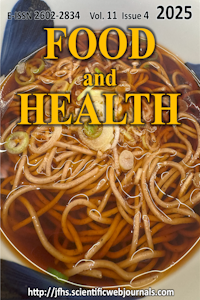Abstract
References
- Abdel-Aal, E.-S., & Hucl, P. (2002). Amino acid composition and in vitro protein digestibility of selected ancient wheats and their end products. Journal of Food Composition and Analysis, 15(6), 737–747. https://doi.org/10.1006/jfca.2002.1094
- Aljada, B., Zohni, A., & El-Matary, W. (2021). The gluten-free diet for celiac disease and beyond. Nutrients, 13(11), 3993. https://doi.org/10.3390/nu13113993
- Alt, K. W., Al-Ahmad, A., & Woelber, J. P. (2022). Nutrition and health in human evolution–past to present. Nutrients, 14(17), 3594. https://doi.org/10.3390/nu14173594
- Bodwell, C., Satterlee, L., & Hackler, L. (1980). Protein digestibility of the same protein preparations by human and rat assays and by in vitro enzymic digestion methods. The American Journal of Clinical Nutrition, 33(3), 677–686. https://doi.org/10.1093/ajcn/33.3.677
- Boye, J., Wijesinha-Bettoni, R., & Burlingame, B. (2012). Protein quality evaluation twenty years after the introduction of the protein digestibility corrected amino acid score method. British Journal of Nutrition, 108(S2), S183–S211. https://doi.org/10.1017/S0007114512002309
- Caire-Juvera, G., Vázquez-Ortiz, F.A., & Grijalva-Haro, M.I. (2013). Amino acid composition, score and in vitro protein digestibility of foods commonly consumed in northwest Mexico. Nutrición Hospitalaria, 28(2), 365–371.
- Culetu, A., Susman, I.E., Duta, D.E., & Belc, N. (2021). Nutritional and functional properties of gluten-free flours. Applied Sciences, 11(14), 6283. https://doi.org/10.3390/app11146283
- De la Luz Guerrero-Elizarraráz, M., Mares-Mares, E., & Sosa-Morales, M.E. (2017). Physicochemical, sensory and nutritional evaluation of gluten-free bread based on rice and soybean flour. Introduction. 1. https://doi.org/10.13031/aim.201700982
- Erbersdobler, H., Barth, C., & Jahreis, G. (2017). Legumes in human nutrition. Nutrient content and protein quality of pulses. Ernährungs-Umschau, 64(9), 134–139.
- FAO/WHO/UNU (1985). Energy and protein requirements report of a joint FAO/WHO/UNU expert consultation [Online]. https://pubmed.ncbi.nlm.nih.gov/3937340/ (Accessed 30 Semptember 2025).
- FAO (1991). Protein quality evaluation. Food and Agriculture Organization of the United Nations: Rome, Italy, 51, 1–66.
- FAO (2007). Protein and amino acid requirements in human nutrition. Report of a joint WHO/FAO/UNU expert consultation [Online]. https://pubmed.ncbi.nlm.nih.gov/18330140/ (Accessed 30 Semptember 2025).
- Gahlawat, P., & Sehgal, S. (1998). Protein and starch digestibilities and mineral availability of products developed from potato, soy and corn flour. Plant Foods for Human Nutrition, 52, 151–160. https://doi.org/10.1023/A:1008045023304
- Iovan, M., Radu, F., & Rotaru, L. (2016). Amaranthus Hypochondriacus and Chenopodium Quinoa, Ingredients with High Nutritive Value in Gluten-Free Sweet Products Formulations. Revista De Chimie, 67(5), 902–907.
- Kamel, M., Aly, M.H.H., & Abd-El-Khalek, M.H. (2020). Preparation of gluten-free corn crackers supplemented with some legume flours. Journal of Advanced Research in Food Science and Nutrition, 3(1), 42–49. https://doi.org/10.24321/2582.3892.202006
- Köseoğlu, S.Z.A. (2019). Bazı tahıl ürünlerinin protein kalite indeksinin protein sindirilebilirliği–düzeltilmiş amino asit skoru (PDCAAS) metodu ile belirlenmesi. Avrupa Bilim ve Teknoloji Dergisi, 17, 477–482. https://doi.org/10.31590/ejosat.633638
- Lee, W.T., Weisell, R., Albert, J., Tomé, D., Kurpad, A.V., & Uauy, R. (2016). Research approaches and methods for evaluating the protein quality of human foods proposed by an FAO expert working group in 2014. The Journal of Nutrition, 146(5), 929–932. https://doi.org/10.3945/jn.115.222109
- Leser, S. (2013). The 2013 FAO report on dietary protein quality evaluation in human nutrition: Recommendations and implications. Nutrition Bulletin, 38(4), 421–428. https://doi.org/10.1111/nbu.12063
- Miranda, J., Lasa, A., Bustamante, M., Churruca, I., & Simon, E. (2014). Nutritional differences between a gluten-free diet and a diet containing equivalent products with gluten. Plant Foods for Human Nutrition, 69, 182–187. https://doi.org/10.1007/s11130-014-0410-4
- Missbach, B., Schwingshackl, L., Billmann, A., Mystek, A., Hickelsberger, M., Bauer, G., & König, J. (2015). Gluten-free food database: The nutritional quality and cost of packaged gluten-free foods. PeerJ, 3, e1337. https://doi.org/10.7717/peerj.1337
- Nosworthy, M.G., Medina, G., Franczyk, A.J., Neufeld, J., Appah, P., Utioh, A., Frohlich, P., Tar’An, B., & House, J.D. (2020). Thermal processing methods differentially affect the protein quality of Chickpea (Cicer arietinum). Food Science & Nutrition, 8(6), 2950–2958. https://doi.org/10.1002/fsn3.1597
- Pedersen, B., & Eggum, B. (1983). The influence of milling on the nutritive value of flour from cereal grains. 4. Rice. Plant Foods for Human Nutrition, 33, 267–278. https://doi.org/10.1007/BF01094752
- Rachman, A., Brennan, M.A., Morton, J., Torrico, D., & Brennan, C.S. (2023). In-vitro digestibility, protein digestibility corrected amino acid, and sensory properties of banana-cassava gluten-free pasta with soy protein isolate and egg white protein addition. Food Science and Human Wellness, 12(2), 520–527. https://doi.org/10.1016/j.fshw.2022.07.054
- Ruales, J., Grijalva, Y. de, Lopez-Jaramillo, P., & Nair, B.M. (2002). The nutritional quality of an infant food from quinoa and its effect on the plasma level of insulin-like growth factor-1 (IGF-1) in undernourished children. International Journal of Food Sciences and Nutrition, 53(2), 143–154. https://doi.org/10.1080/09637480220132157
- Sabença, C., Ribeiro, M., Sousa, T. de, Poeta, P., Bagulho, A.S., & Igrejas, G. (2021). Wheat/gluten-related disorders and gluten-free diet misconceptions: A review. Foods, 10(8), 1765. https://doi.org/10.3390/foods10081765
- Schaafsma, G. (2005). The protein digestibility-corrected amino acid score (PDCAAS)—A concept for describing protein quality in foods and food ingredients: A critical review. Journal of AOAC International, 88(3), 988–994. https://doi.org/10.1093/jaoac/88.3.988
- Sevim, S., Gümüş, D., & Kızıl, M. (2023). Türkiye’de satışa sunulan glütensiz ürünler ile glüten içeren eşdeğerlerinin besin ögesi içeriği ve maliyet yönünden değerlendirilmesi. Akademik Gıda, 21(3), 264–273. https://doi.org/10.24323/akademik-gida.1382929
- Shewry, P. (2019). What is gluten? Why is it special? Frontiers in Nutrition, 6, 101. https://doi.org/10.3389/fnut.2019.00101
- Smolinska, S., Jurkiewicz, K., & Majsiak, E. (2025). Recent Advances in Gluten-Related Disorders. International Journal of Molecular Sciences, 26(4), 1749. https://doi.org/10.3390/ijms26041749
- Stone, A.K., Nosworthy, M.G., Chiremba, C., House, J.D., & Nickerson, M.T. (2019). A comparative study of the functionality and protein quality of a variety of legume and cereal flours. Cereal Chemistry, 96(6), 1159–1169. https://doi.org/10.1002/cche.10226
- Sung, W.C., Chiu, E.T., Sun, A., & Hsiao, H.I. (2020). Incorporation of chia seed flour into gluten‐free rice layer cake: Effects on nutritional quality and physicochemical properties. Journal of Food Science, 85(3), 545–555. https://doi.org/10.1111/1750-3841.14841
- Wu, J.H., Neal, B., Trevena, H., Crino, M., Stuart-Smith, W., Faulkner-Hogg, K., Louie, J.C.Y., & Dunford, E. (2015). Are gluten-free foods healthier than non-gluten-free foods? An evaluation of supermarket products in Australia. British Journal of Nutrition, 114(3), 448–454. https://doi.org/10.1017/S0007114515002056
- Yang, M., Duan, Y., Liang, W., Peiris, D.L.I.H.K., & Baker, J.S. (2023). Effects of face-to-face and ehealth blended interventions on physical activity, diet, and weight-related outcomes among adults: A systematic review and meta-analysis. International Journal of Environmental Research and Public Health, 20(2), 1560. https://doi.org/10.3390/ijerph20021560
Assessment of Protein Quality in Gluten-Free and Gluten-Containing Food Products: Insights from the PDCAAS Method
Abstract
This study aims to investigate the protein quality of gluten-free products and gluten-containing products using the Protein Digestibility Corrected Amino Acid Score (PDCAAS) method. Twenty gluten-free and twenty gluten-containing products were selected, including various types of flour, bread, pasta, crackers, biscuits, and cakes. Amino acid contents were obtained from TURKOMP, USDA, and literature research. Protein contents of products were between 2.63-52.5 g/100g and 2.4-13.4 g/100 g for gluten-free and gluten-containing products, respectively. PDCAAS scores of gluten-free products and gluten-containing products were found to be between 0.2% and 100%, and 34.4% and 100%, respectively. Peanut flour, soy flour, and chickpea flour can be a preferable alternative for gluten-free recipes with their high protein content. Gluten-free products made from rice flour and sorghum flour have been found to have the highest protein quality. In conclusion, the amount and quality of protein in gluten-free products can vary depending on the type of protein sources used. In a gluten-free diet, products with high protein quantity and quality should be preferred.
Ethical Statement
The authors declare that this study does not involve experiments with human or animal subjects, and therefore, ethics committee approval is not required.
References
- Abdel-Aal, E.-S., & Hucl, P. (2002). Amino acid composition and in vitro protein digestibility of selected ancient wheats and their end products. Journal of Food Composition and Analysis, 15(6), 737–747. https://doi.org/10.1006/jfca.2002.1094
- Aljada, B., Zohni, A., & El-Matary, W. (2021). The gluten-free diet for celiac disease and beyond. Nutrients, 13(11), 3993. https://doi.org/10.3390/nu13113993
- Alt, K. W., Al-Ahmad, A., & Woelber, J. P. (2022). Nutrition and health in human evolution–past to present. Nutrients, 14(17), 3594. https://doi.org/10.3390/nu14173594
- Bodwell, C., Satterlee, L., & Hackler, L. (1980). Protein digestibility of the same protein preparations by human and rat assays and by in vitro enzymic digestion methods. The American Journal of Clinical Nutrition, 33(3), 677–686. https://doi.org/10.1093/ajcn/33.3.677
- Boye, J., Wijesinha-Bettoni, R., & Burlingame, B. (2012). Protein quality evaluation twenty years after the introduction of the protein digestibility corrected amino acid score method. British Journal of Nutrition, 108(S2), S183–S211. https://doi.org/10.1017/S0007114512002309
- Caire-Juvera, G., Vázquez-Ortiz, F.A., & Grijalva-Haro, M.I. (2013). Amino acid composition, score and in vitro protein digestibility of foods commonly consumed in northwest Mexico. Nutrición Hospitalaria, 28(2), 365–371.
- Culetu, A., Susman, I.E., Duta, D.E., & Belc, N. (2021). Nutritional and functional properties of gluten-free flours. Applied Sciences, 11(14), 6283. https://doi.org/10.3390/app11146283
- De la Luz Guerrero-Elizarraráz, M., Mares-Mares, E., & Sosa-Morales, M.E. (2017). Physicochemical, sensory and nutritional evaluation of gluten-free bread based on rice and soybean flour. Introduction. 1. https://doi.org/10.13031/aim.201700982
- Erbersdobler, H., Barth, C., & Jahreis, G. (2017). Legumes in human nutrition. Nutrient content and protein quality of pulses. Ernährungs-Umschau, 64(9), 134–139.
- FAO/WHO/UNU (1985). Energy and protein requirements report of a joint FAO/WHO/UNU expert consultation [Online]. https://pubmed.ncbi.nlm.nih.gov/3937340/ (Accessed 30 Semptember 2025).
- FAO (1991). Protein quality evaluation. Food and Agriculture Organization of the United Nations: Rome, Italy, 51, 1–66.
- FAO (2007). Protein and amino acid requirements in human nutrition. Report of a joint WHO/FAO/UNU expert consultation [Online]. https://pubmed.ncbi.nlm.nih.gov/18330140/ (Accessed 30 Semptember 2025).
- Gahlawat, P., & Sehgal, S. (1998). Protein and starch digestibilities and mineral availability of products developed from potato, soy and corn flour. Plant Foods for Human Nutrition, 52, 151–160. https://doi.org/10.1023/A:1008045023304
- Iovan, M., Radu, F., & Rotaru, L. (2016). Amaranthus Hypochondriacus and Chenopodium Quinoa, Ingredients with High Nutritive Value in Gluten-Free Sweet Products Formulations. Revista De Chimie, 67(5), 902–907.
- Kamel, M., Aly, M.H.H., & Abd-El-Khalek, M.H. (2020). Preparation of gluten-free corn crackers supplemented with some legume flours. Journal of Advanced Research in Food Science and Nutrition, 3(1), 42–49. https://doi.org/10.24321/2582.3892.202006
- Köseoğlu, S.Z.A. (2019). Bazı tahıl ürünlerinin protein kalite indeksinin protein sindirilebilirliği–düzeltilmiş amino asit skoru (PDCAAS) metodu ile belirlenmesi. Avrupa Bilim ve Teknoloji Dergisi, 17, 477–482. https://doi.org/10.31590/ejosat.633638
- Lee, W.T., Weisell, R., Albert, J., Tomé, D., Kurpad, A.V., & Uauy, R. (2016). Research approaches and methods for evaluating the protein quality of human foods proposed by an FAO expert working group in 2014. The Journal of Nutrition, 146(5), 929–932. https://doi.org/10.3945/jn.115.222109
- Leser, S. (2013). The 2013 FAO report on dietary protein quality evaluation in human nutrition: Recommendations and implications. Nutrition Bulletin, 38(4), 421–428. https://doi.org/10.1111/nbu.12063
- Miranda, J., Lasa, A., Bustamante, M., Churruca, I., & Simon, E. (2014). Nutritional differences between a gluten-free diet and a diet containing equivalent products with gluten. Plant Foods for Human Nutrition, 69, 182–187. https://doi.org/10.1007/s11130-014-0410-4
- Missbach, B., Schwingshackl, L., Billmann, A., Mystek, A., Hickelsberger, M., Bauer, G., & König, J. (2015). Gluten-free food database: The nutritional quality and cost of packaged gluten-free foods. PeerJ, 3, e1337. https://doi.org/10.7717/peerj.1337
- Nosworthy, M.G., Medina, G., Franczyk, A.J., Neufeld, J., Appah, P., Utioh, A., Frohlich, P., Tar’An, B., & House, J.D. (2020). Thermal processing methods differentially affect the protein quality of Chickpea (Cicer arietinum). Food Science & Nutrition, 8(6), 2950–2958. https://doi.org/10.1002/fsn3.1597
- Pedersen, B., & Eggum, B. (1983). The influence of milling on the nutritive value of flour from cereal grains. 4. Rice. Plant Foods for Human Nutrition, 33, 267–278. https://doi.org/10.1007/BF01094752
- Rachman, A., Brennan, M.A., Morton, J., Torrico, D., & Brennan, C.S. (2023). In-vitro digestibility, protein digestibility corrected amino acid, and sensory properties of banana-cassava gluten-free pasta with soy protein isolate and egg white protein addition. Food Science and Human Wellness, 12(2), 520–527. https://doi.org/10.1016/j.fshw.2022.07.054
- Ruales, J., Grijalva, Y. de, Lopez-Jaramillo, P., & Nair, B.M. (2002). The nutritional quality of an infant food from quinoa and its effect on the plasma level of insulin-like growth factor-1 (IGF-1) in undernourished children. International Journal of Food Sciences and Nutrition, 53(2), 143–154. https://doi.org/10.1080/09637480220132157
- Sabença, C., Ribeiro, M., Sousa, T. de, Poeta, P., Bagulho, A.S., & Igrejas, G. (2021). Wheat/gluten-related disorders and gluten-free diet misconceptions: A review. Foods, 10(8), 1765. https://doi.org/10.3390/foods10081765
- Schaafsma, G. (2005). The protein digestibility-corrected amino acid score (PDCAAS)—A concept for describing protein quality in foods and food ingredients: A critical review. Journal of AOAC International, 88(3), 988–994. https://doi.org/10.1093/jaoac/88.3.988
- Sevim, S., Gümüş, D., & Kızıl, M. (2023). Türkiye’de satışa sunulan glütensiz ürünler ile glüten içeren eşdeğerlerinin besin ögesi içeriği ve maliyet yönünden değerlendirilmesi. Akademik Gıda, 21(3), 264–273. https://doi.org/10.24323/akademik-gida.1382929
- Shewry, P. (2019). What is gluten? Why is it special? Frontiers in Nutrition, 6, 101. https://doi.org/10.3389/fnut.2019.00101
- Smolinska, S., Jurkiewicz, K., & Majsiak, E. (2025). Recent Advances in Gluten-Related Disorders. International Journal of Molecular Sciences, 26(4), 1749. https://doi.org/10.3390/ijms26041749
- Stone, A.K., Nosworthy, M.G., Chiremba, C., House, J.D., & Nickerson, M.T. (2019). A comparative study of the functionality and protein quality of a variety of legume and cereal flours. Cereal Chemistry, 96(6), 1159–1169. https://doi.org/10.1002/cche.10226
- Sung, W.C., Chiu, E.T., Sun, A., & Hsiao, H.I. (2020). Incorporation of chia seed flour into gluten‐free rice layer cake: Effects on nutritional quality and physicochemical properties. Journal of Food Science, 85(3), 545–555. https://doi.org/10.1111/1750-3841.14841
- Wu, J.H., Neal, B., Trevena, H., Crino, M., Stuart-Smith, W., Faulkner-Hogg, K., Louie, J.C.Y., & Dunford, E. (2015). Are gluten-free foods healthier than non-gluten-free foods? An evaluation of supermarket products in Australia. British Journal of Nutrition, 114(3), 448–454. https://doi.org/10.1017/S0007114515002056
- Yang, M., Duan, Y., Liang, W., Peiris, D.L.I.H.K., & Baker, J.S. (2023). Effects of face-to-face and ehealth blended interventions on physical activity, diet, and weight-related outcomes among adults: A systematic review and meta-analysis. International Journal of Environmental Research and Public Health, 20(2), 1560. https://doi.org/10.3390/ijerph20021560
Details
| Primary Language | English |
|---|---|
| Subjects | Nutritional Science |
| Journal Section | Research Article |
| Authors | |
| Early Pub Date | October 2, 2025 |
| Publication Date | October 2, 2025 |
| Submission Date | April 3, 2025 |
| Acceptance Date | June 30, 2025 |
| Published in Issue | Year 2025 Volume: 11 Issue: 4 |
Journal is licensed under a
CreativeCommons Attribtion-ShareAlike 4.0 International Licence 


Diamond Open Access refers to a scholarly publication model in which journals and platforms do not charge fees to either authors or readers.
Open Access Statement:
This is an open access journal which means that all content is freely available without charge to the user or his/her institution. Users are allowed to read, download, copy, distribute, print, search, or link to the full texts of the articles, or use them for any other lawful purpose, without asking prior permission from the publisher or the author. This is in accordance with the BOAI definition of open access.
Archiving Policy:
Archiving is done according to ULAKBİM "DergiPark" publication policy (LOCKSS).

